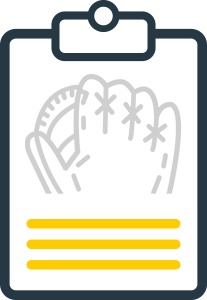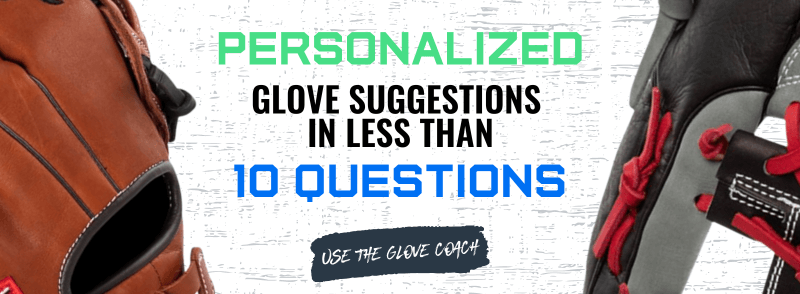Purchasing a new baseball glove sounds so easy. And in years past it probably went something like the following: (1) Go to the sporting goods store (2) Grab the glove you think looks cool (3) Buy it.
But in baseball today there is a high emphasis on performance. Parents want to get their player a glove that looks good, but also one that can field and catch a baseball properly. If you're a parent that has found yourself in this situation, then you've arrived at the right place. We'll teach you what you need to know about sizing a glove properly. By knowing how to size a glove and also knowing the correct size of glove that your player needs, you should be able to help them field and catch the ball at a high level.
Keep reading to find out the 5 steps of sizing a glove for your player!
STEP 1: Understand Your Glove's Basic Anatomy
The best place to start when it comes to baseball glove sizing is glove anatomy. It’s good to know which part of a glove is which before you get started. Ensure that you know the basic components:
- Index Finger - Nearly all gloves come with four fingers in addition to the thumb. Gloves are typically designed with each of your fingers to go into the corresponding finger on the glove (i.e. your index finger goes in the glove's index finger)
- Palm - The palm of your glove is the general area where a player will be catching the baseball most of the time (ideally the ball will be caught in the pocket; just below the web). The palm shell consists of a single piece of leather that encompasses the palm, fingers and thumb of a glove.
- Heel - This is the very base of your glove. Usually this part of the glove is padded to assist fielders in handling ground balls.
.png)
STEP 2: Understand How A Glove's Length Is Measured
When a manufacturer measures the length of a fielders glove or first base mitt, they are measuring from the bottom of the heel of the glove to the tip of the glove's index finger. Be mindful that they make this measurment based on the length between the bottom of the heel and tip of the index finger on the die being used to cut the palm shell leather. In other words, they measure the length of the glove before it is put together when the palm leather is laid flat on a table.
If you are going to measure the length of a glove that is already constructed, the best way to measure is to use a paper ruler (it can curve as the glove's index finger, palm and heel curve). However, be sure to note that there will most likely be a discrepancy in your measurement and what the manufacturer lists as the length due to the leather being warped a small amount during its construction.
Catcher's mitts are a little different than fielders gloves and first base mitts. They are measured by the circumference of the mitt's palm shell. See image below to understand best:

We would offer the same advice as above regarding a home measurement of a catcher's mitt circumference. To get the best reading, be sure to do the measurement with a paper ruler, but know that your measurement may differ from the listed circumference due to the leather being warped during the mitts's construction.
STEP 3: Know Your Position
Before we start here, be sure to know that every baseball glove and mitt has the size etched in the leather on the thumb or pinky finger of the glove. You can always use that as a guide on the correct size of glove to buy next. If your player likes their current glove and is performing well, then stick with that same length. But if the glove is not serving your player well, be sure to take a look at our suggestions on how to determine a glove size based on your position:
- Infield Gloves - Infielders are generally going to use gloves sized 11 inches to 12 inches in length. Many younger players will use a glove shorter than 11 inches on the infield and some older infielders might use a 12.25 inch glove.
- Outfield Gloves - Players typically don't "specialize" in outfield until they've been playing for a handful of years (usually early teens). If you have a really young player, feel free to bring anything into the outfield. But once an early teen has determined that outfield is their position, we've seen that a 12.5 inch to 13 inch glove works best.
- Pitcher's Gloves - If your player has found that they're only pitching (oftentimes referred to as a "PO") we usually say that an 11.75 inch or 12 inch glove works best. These sizes provide enough length and body to shield a pitchers hand from the batter (be sure to get a closed web too). However, young players can bring any glove with them to the pitcher's mound.
- First Base Gloves & Mitts - These mitts range in size from 10.5 inches all the way to 13 inches. Typically, you want a large mitt as it is helpful for picking errant throws that often come your way at first base. Suggestions here can vary quite a bit depending on age (it's hard to provide a general answer) and we'd recommend checking our chart in the next section.
- Catcher's Gloves & Mitts - Similar to first base mitts above, the answer can vary greatly depending on the age of your player and a general answer is hard to provide. We'll have catcher's mitts ranging in size from 30 inches in circumference to 35 inches in circumference. Check our age chart in the next section for the best sizing answers!
STEP 4: Select Your Size
At this point, we believe most of you should be able to select a size based on knowing a glove's basic components, how its length (or circumference) is measured and your position. But every situation is unique. This is especially true regarding youth gloves. If you are in need of the most straight forward answers on the size of glove to purchase based on your players age and position, please reference the table below:
| AGE | Under 8 | 8 - 10 | 11 - 13 | Over 13 |
|---|---|---|---|---|
| CATCHER | 30" | 30 - 31" | 30 - 32.5" | 32 - 35" |
| FIRST BASE | 10.5" | 10.5 - 12" | 11.5 - 12" | 12 - 13" |
| SECOND BASE / SHORT STOP | 9 - 10.5" | 10.5 - 11.25" | 11 - 11.5" | 11.25 - 11.5" |
| THIRD BASE | 9 - 10.5" | 10.5 - 11.5" | 11 - 11.75" | 11.5 - 12" |
| PITCHER | 9 - 10.5" | 10.5 - 11.5" | 11.5 - 12" | 11.5 - 12" |
| OUTFIELD | 9 - 10.5" | 10 - 12" | 11.75 - 12.75" | 12 - 13" |
STEP 5: Get Your Glove!
Now that you’re a glove sizing pro, it’s time to choose a baseball glove.
Once you’ve got the glove of your dreams, make sure to break in your glove the right way.
BONUS STEP: Glove Buying Tips:
- Righty or Lefty: Know if you or your player are a right hand thrower or a left hand thrower. Whichever hand you use to throw, the other hand will wear the glove.
- Buy for Your Needs: Select a glove that fits your price range and estimated use. For a little leaguer just starting out, you can opt for a cheaper glove that breaks in faster. But if the player is over 12 and plans to play for the next few years, choosing a nicer, real-leather glove will be well worth the price.
- Trust yourself. After all, it is your game that will be affected by your glove. When looking at the pocket depth, webbing pattern, and finger stalls, choose the size that feels the best to you and performs how you need it.
___
The size recommendations mentioned above are an average and may not pertain to every single player, so make sure you select a size based on our size chart and your personal preferences. Have no fear on size selection! Thanks to the JustGloves Glove Assurance, you can pay a tad more to try your glove out, break it in, and still return it. So, if your baseball glove doesn't fit you perfectly, you aren’t stuck with too long or too short glove.
Still need help sizing a baseball glove? Let us help! If you have any questions, please give our Glove Experts a call at 866-321-4568, email via experts@justgloves.com Live Chat now. They are available and will be there for you from click to catch!



.jpg)

